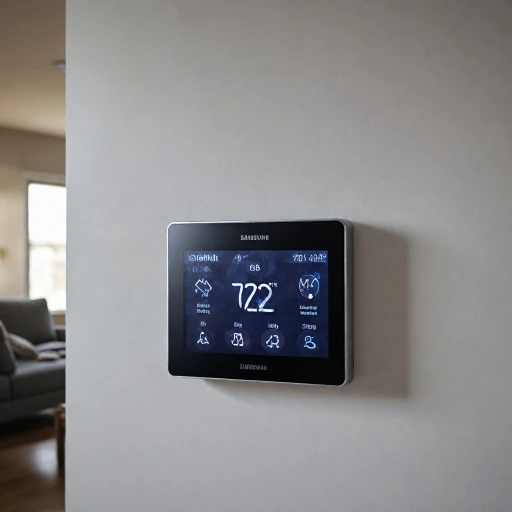What is a Heat Pump Thermostat?
Delving into the Concept of Heat Pump Thermostats
Heat pump thermostats are central devices in modern homes, enabling precise control over heating and cooling systems. These thermostats are tailor-made to regulate the operation of heat pumps, which are highly efficient for temperature management, whether it’s beating the winter chill or cooling down during hot summers. With models ranging from programmable options like the Honeywell RTH to smart thermostats that integrate with platforms such as Google, there’s a wide variety of choices that cater to different tech preferences and energy efficiency needs.
In essence, the heat pump thermostat acts as the brain of your heating and cooling system. It effectively manages the heat pump’s operations, ensuring an optimal balance between comfort and energy consumption. A smart thermostat isn’t just about controlling temperature—these devices offer advanced capabilities that can lead to significant savings on energy bills.
Integrating with Alexa and other smart home systems, many modern thermostats have facades that appear simple but pack a punch with their intelligent features. They automatically adjust the temperature based on your habits, preferences, and even weather changes, maintaining efficiency without compromising on comfort. For example, some models come with features like programmable heat or programmable thermostat settings, which allow users to customize heating schedules according to their lifestyle.
Moreover, heat pump thermostats are subject to various stars reviews, reflecting their effectiveness and user satisfaction. They often carry the Energy Star label, signifying compliance with energy efficiency standards in the United States, making them a preferred choice for environmentally conscious homeowners.
Choosing the right thermostat can be challenging with so many options available—from high-tech Honeywell Pro models to user-friendly digital thermostats. Yet, it's crucial to consider not just the technological flair but how each model aligns with your particular system, whether it’s a mini split or a single stage unit.
For those looking to tap into the power of smart technology to enhance home comfort, you might find our detailed insights on the topic here useful.
Benefits of Using a Heat Pump Thermostat
Advantages of Implementing a Modern Pump Thermostat
Incorporating a pump thermostat into your home heating and cooling system can significantly transform the efficiency and comfort of your environment. These smart thermostats are designed to work especially well with heat pumps, providing a range of benefits tailored to suit contemporary lifestyles. Firstly, when it comes to energy management, a smart thermostat for heat pumps stands out. This system facilitates precise temperature control, thereby optimizing the energy usage. By dynamically adjusting to the climatic conditions and occupancy patterns, these thermostats can reduce the energy consumption significantly. Homeowners often notice decreased utility bills after switching to these efficient devices, highlighting their cost-saving potential. Moreover, many thermostats, including models like Honeywell Pro and Google Nest, offer programmable features that allow users to set schedules for heating and cooling. This means that your home can be warm when you wake up and cool when you get back from work without any manual intervention. As technology advances, devices such as the Mysa smart thermostat even integrate seamlessly with your existing systems to further refine the control you have over your home's climate. These programmable heat systems are not only about luxury; they contribute to environmental sustainability. With features that meet Energy Star requirements, they align with the growing global emphasis on energy conservation. By using heat more efficiently, these thermostats contribute to reducing your carbon footprint. Real-world results from various reviews highlight that people in the United States often give high stars reviews for their operational efficiency and reliability. Among popular choices are electric heating systems and mini splits, with single stage and programmable heat management options being preferred. In light of the above, exploring the benefits of these advanced thermostats can be an insightful starting point for those considering an upgrade to their home automation. While the positive impacts are evident, it’s crucial for homeowners to be aware of common challenges associated with pump thermostats, which will be addressed in the following sections.How Heat Pump Thermostats Integrate with Smart Home Systems
Seamless Integration with Smart Home Systems
One of the promising aspects of a heat pump thermostat is its ability to seamlessly integrate with smart home systems, making temperature management more efficient and convenient. Modern smart thermostats, such as the Honeywell Pro or the Google Nest, bring advanced features that enhance the overall functionality of your heating and cooling system.
Most digital and programmable thermostats, including the single stage options, are designed to interface with smart devices and platforms like Alexa. This integration allows users to control their heating and cooling preferences remotely. By setting your preferred temperature through voice commands or smartphone apps, you can significantly optimize your home's energy efficiency and comfort.
- Control and Connectivity: Many smart thermostats provide excellent connectivity options, ensuring that you can adjust the heat cool settings from anywhere in the United States, which is especially useful for those with mini split systems or electric heat pump setups.
- Energy Efficiency and Stars Reviews: It's crucial to consider a thermostat's energy star rating. Models with higher stars reviews often come with enhanced features that can reduce energy consumption while delivering optimum comfort.
- Flexibility and Programmability: Brands like Honeywell RTH offer programmable thermostat options that provide tailored heating and cooling schedules. This flexibility not only saves energy but also extends the life of your HVAC system.
Incorporating smart thermostats into your home system is an investment that pays off in terms of convenience and savings on energy bills. These devices, powered by advanced analytics and user-friendly interfaces, elevate the functionality of any home HVAC setup, including heat pumps and traditional systems. For more insights on how smart thermostats can enhance your home’s comfort, consider visiting this smart heated floor thermostats guide.
Common Challenges with Heat Pump Thermostats
Challenges in Adopting Heat Pump Thermostat Technology
While heat pump thermostats offer numerous benefits for energy efficiency and temperature regulation, there are certain challenges that homeowners may face when integrating these devices into their homes. Understanding these potential hurdles can help in making informed decisions and maximizing the value of your system.
- Compatibility Issues: One of the most common challenges is ensuring compatibility with existing heating and cooling systems, particularly for homes equipped with older HVAC systems. Many modern smart thermostats, like those from Honeywell and Google, require certain wiring configurations that older systems might lack.
- Complex Installation: Installing a heat pump thermostat can be more complex than regular programmable thermostats. For example, setting up a programmable heat or programmable heat-cool system may require professional installation to ensure optimal operation and efficiency.
- Learning Curve: The advanced features of smart thermostats, such as programmable settings and integration with digital assistants like Alexa, can sometimes be intimidating for new users. It is essential to spend time understanding how to fully utilize these features for better control and energy management.
- System Limitations: Not all heat pump thermostats support systems like mini splits or single stage setups. Selecting the right product requires careful consideration of your current heating and cooling infrastructure.
- Reliability Concerns: Like any smart device, there is a possibility of software glitches or connectivity issues, especially with sponsored products that have not yet gained widespread customer trust or have limited stars reviews. Reading multiple stars reviews can provide insights into product reliability.
Despite these challenges, the long-term benefits of reduced energy consumption and improved home comfort often outweigh the initial difficulties. Choosing the best suited heat pump thermostat could significantly enhance your home’s comfort, with models such as the Honeywell Pro and Honeywell RTH offering reputable performance in the United States market.
Choosing the Right Heat Pump Thermostat for Your Home
Factors to Consider When Selecting a Heat Pump Thermostat
Choosing the right heat pump thermostat is critical to optimize the heating and cooling efficiency of your home. With so many options on the market today – from Honeywell Pro and Honeywell RTH to smart thermostats that integrate with Alexa – it's important to balance your specific needs with features that these devices offer.- Compatibility: Always ensure the thermostat is compatible with your existing heating and cooling system. Whether you have a single-stage or variable speed heat pump system, the thermostat should support it adequately.
- Programmable Features: A programmable thermostat can significantly contribute to energy savings by allowing you to maintain ideal temperatures throughout the day. Products that let you set different schedules for weekdays and weekends can be especially useful.
- Smart Integration: Increasingly popular, smart thermostats like those from Google and Mysa offer seamless integration with other smart home devices. If your home is already operated by a digital assistant, make sure your new thermostat can be controlled through voice commands or a mobile app.
- Energy Efficiency: Look for thermostats with Energy Star certifications, which signals they meet energy efficiency guidelines. Some devices might have white star or other ratings that further underline their efficiency.
- User-Friendly Design: Whether you're looking at a Honeywell or a different brand, its digital display should be easy to read, and the interface intuitive to navigate. Consider a model that displays all necessary information clearly and allows for straightforward control adjustments.
- Customer Reviews: It's advisable to read through ratings and stars reviews before making a purchase. Real user experiences can provide insight into how the thermostat performs in different settings.
- Price and Warranty: Price should also be a consideration. While some high-end models come with advanced features, ensure they align with your personal needs and budget. A good warranty can also add value to the product, signaling its durability and the manufacturer's confidence in it.





